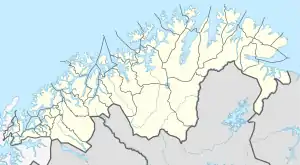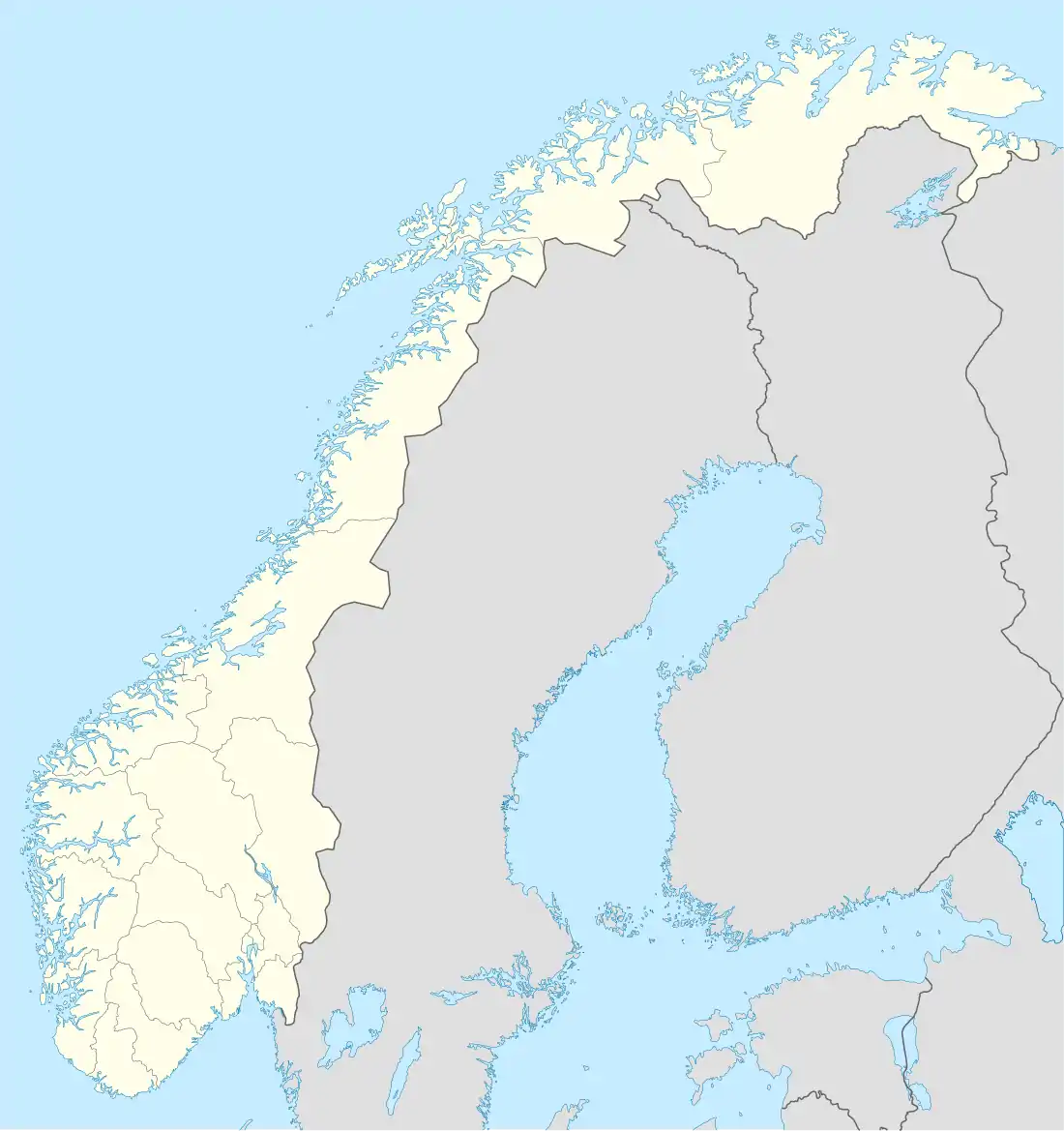Neiden, Norway
Neiden (Skolt Sami: Njauddâm, Northern Sami: Njávdán, Inari Sami: Njiävđám, and Finnish: Näätämö, previously also Näytämö) is a village area in the Sápmi area along the Finland–Norway border with about 250 inhabitants. Neiden, situated along the Neiden River, actually consists of two villages separated by the border of Norway and Finland. One side is in Sør-Varanger Municipality in Troms og Finnmark county, Norway and the other side is in Inari Municipality in Lapland, Finland. Neiden is the official name in Norway and Näätämö in Finland. The European route E6 highway runs through the Norwegian village of Neiden. In Finnish view Neiden/Näätämö extends into Finland, and there is a small village in Finland near the border called Näätämö, with border shops, around 12 km from Neiden village centre.
Neiden
Näätämö | |
|---|---|
Village | |
 View of the village | |
 Neiden Location in Norway  Neiden Neiden (Norway) | |
| Coordinates: 69°41′45″N 29°22′39″E | |
| Country | Norway |
| Region | Northern Norway |
| County | Troms og Finnmark |
| District | Øst-Finnmark |
| Municipality | Sør-Varanger |
| Elevation | 41 m (135 ft) |
| Time zone | UTC+01:00 (CET) |
| • Summer (DST) | UTC+02:00 (CEST) |
| Post Code | 9930 Neiden |
History
Neiden became the main settlement of the westernmost Njauddâm sijdd (Northern Sami: siida, i.e. the fundamental unit of the old Sami society, indicating both the area and the family group(s) exploiting it) of the Skolts and has remained relatively unchanged, leaving numerous traces of earlier use of the area intact.
Neiden was governmentally divided officially in 1852. The reason for that separation was the demarcation treaty between the Kingdom of Sweden-Norway and the Grand Duchy of Finland, which prohibited nomadic reindeer herding and moving of fishermen over the border. That caused much harm to reindeer husbandry for a long time.
World War Two
On 26 and 27 October 1944 around two hundred soldiers (from the Soviet forces and from the German forces) were killed.[2]
People
Most inhabitants of Neiden are Sami, Kven, and Norwegians.
Skolt Sami
The Skolts form a minority group among the Sami and are distinct from other groups in a number of ways. The Russian culture has had a strong influence on the Skolts, who adopted Christianity in its Eastern Orthodox form in the 16th century. The Skolt Sami language is highly endangered and not spoken actively in Neiden today. Almost all speakers live in Finland. The Ä'vv Skolt Sami Museum, situated in Neiden, officially opened in June 2016. A Skolt Sami tradition maintained until today is the so-called Käpälä-fishing of salmon with a cast net.
Protected area

The protected area in Skoltebyen includes a number of different monuments, some of which are old enough (i.e. more than 100 years) to be automatically protected under the Cultural Heritage Act. These include a Russian Orthodox graveyard, the ruins of a smoke sauna, sixteen sites of traditional turf huts known as gammer and a tiny (13 square metres or 140 square feet) Russian Orthodox chapel, St. Georg's Chapel, build 1565 by Tryphon of Pechenga. In addition, many of the natural features of the area have been and are being used in religious ceremonies, such as baptism.
The formal protection (scheduling) of the settlement was carried out in order to safeguard its historical and religious importance as well as the integrity of the landscape. This is the most important cultural heritage site for the Skolts and their surviving culture in Norway. The protection order was issued to prevent the area from being developed in a way that would reduce its significance and cultural value, while at the same time encouraging use that will communicate, maintain and develop the Skolt culture. The protection order does not affect the commercial salmon fishing in the Neiden River nor other commercial activities in the area.
Religion
The oldest church in Neiden (and in Finnmark) is St. Georg's Russian Orthodox chapel (built 1565), mentioned above. There is also the Lutheran Neiden Chapel, built in 1902 in the classical style of a Norwegian stave church. It was built as part of a deliberate policy of Norwegianization of Eastern Finnmark in the face of fear of Russian encroachment.[3]
See also
References
- "Neiden" (in Norwegian). yr.no. Retrieved 2013-03-15.
- Måtte begrave hundrevis av lik
- "Old and new faiths". Archived from the original on 2016-03-04. Retrieved 2012-09-02.